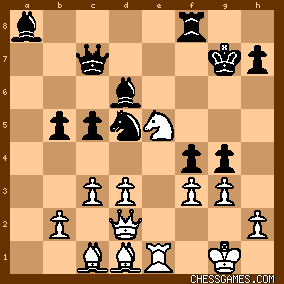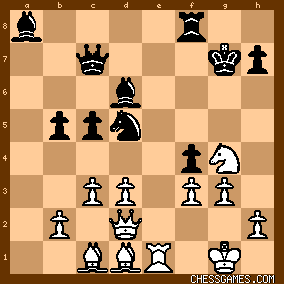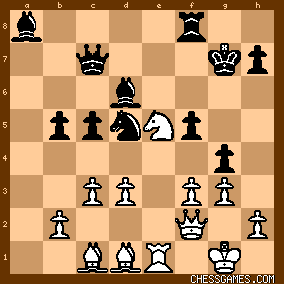|
< Earlier Kibitzing · PAGE 1 OF 2 ·
Later Kibitzing> |
| Oct-28-12 | | C4gambit: ah.. almost !! |
|
Oct-28-12
 | | Phony Benoni: No idea. Given the position of White's pieces, I was almost expecting a defensive combination. Those guys are good. |
|
| Oct-28-12 | | JRMenezes: I thought out the moves till move 30... Rg8 but had no idea how to continue further. If 37... Rg5 38. RxR+ KxR 39. Qf5+ and mate to follow If 37... Kh6 38. QxN+ and mate to follow |
|
| Oct-28-12 | | Rravshan: which part is the puzzle? and from where the high level game continues? there are so many options to continue with, after 2-3 moves. |
|
| Oct-28-12 | | vinidivici: Let me give you how a GM thinks. In the beginning a puzzle white has a pawn up, it means +1.
White sacrificed a knight....aiming Qh6+ if 28...Kg8 then 29.Qe6+ then get back material with eating bishop. Its BENEFITS. So, Kf7 left. That means guarantees h7 pawn. With the sacrificed a knight but get 2 pawns that means -1 for white....not so bad......white get overwhelming attack. After 30.Bh6 Rg8 31.Bxg7 Rxg7 then, the materials even with Qxf5 eating a third pawn. Thats complex but you have to make sure a step by step and take a chance and position advantages. 3 pawns traded with one knight, why not. Of course with BIG ADVANTAGE in position. Theres a weak line with a draw result just what i have thought but again, its a weak line and completely astray. 27.Bh6+ Kxh6
28.Qd2+ Kg7
29.Qg5+ Kh8
30.Ng6+ hxg6
31.Qh6+ Kg8
32.Qxg6+ Kh8. draw
This is the one of the first lines i was thinking but i think its completely weak because black can do 28...f4. Qd2 is a tricky move looks so simple and plain, so i didnt believe that the answer until i wasstrayed with Bh6+. Contemplated long enough, i came back with Qd2. So, i give the puzzle not insane, but very difficult instead. |
|
| Oct-28-12 | | thegoldenband: I had no trouble spotting the key idea of 27. Qd2. Whether I'd have played it OTB, without a little bird perched on my shoulder to tell me "White to play and win", is a different story. But I don't think it's too hard to spot; it initiates a forcing sequence that, thanks to a few quirks of Black's position, can't really be derailed (i.e. moves like 27...Rf6 and 28....Kg8 don't work). |
|
Oct-28-12
 | | al wazir: To my surprise, I actually found the right idea (27. Qd2 with Qh6+ and eventual captures with check on h7 and f5 to follow), though I didn't see it nearly all the way to a win. |
|
| Oct-28-12 | | vardeep: i saw it upto Qh6+.. but then i assumed black would respond with Kg8.. i couldn't come up with anything after that.. i analyzed one possible line with white light squared bishop pinning the black knight on d5.. but even that could be overcome easily.. can someone pl show the possible winning combination if black responds with 28.Kg8 |
|
| Oct-28-12 | | M.Hassan: "Insane"
White to play 27.?
White is a pawn up
I saw two possible lines:
A)
27.Qd2 to capture the diagonal c1h6
27..........Bxe5
28.Qh6+ Kg8
29.Qe6+ Qf7
30.Qxe5 gxf3
31.Bxf3 c4
32.dxc4 bxc4
33.Bh6 Rd8
34.Bh5 Qf6
35.Qe8+ Rxe8
36.Rxe8+ Qf8
37.Rxf8#
B)
27.Qd2 f4
28.Nxg4 if fxg3
29.Qh6+ Kg8
30.Qe6+ Rf7
31.Ne5 Qe7
32.Nxf7 Qxe6
33.Rxe6 Kxf7
34.Rxd6
And White is ahead in exchange by a full Rook.
See the game now |
|
| Oct-28-12 | | Rravshan: Thanks vinidichi!!
for the detailed description, it is really helpful.
the weaker line you showed, i was going through it too, although not that deep. |
|
| Oct-28-12 | | ughaibu: But why did black play 25...Kg7? |
|
Oct-28-12
 | | Eggman: <<vinidivici>> In your "weaker line", beginning with 27.Bh6+, after 27...Kxh6 28.Qd2+ Kg7 29.Qg5+ Kh8 30.Ng6+ hxg6 31.Qh6+ Black can simply play 31...Qh7. |
|
| Oct-28-12 | | lost in space: No, not today. I was completely wrong, thinking about defensive combinations to achieve pers or reps . |
|
| Oct-28-12 | | newzild: <vinidivici>
Like you, I examined the line 27. Bh7+. However, I abandoned it because it loses. You give: <27.Bh6+ Kxh6>
<28.Qd2+ Kg7>
<29.Qg5+ Kh8>
<30.Ng6+ hxg6>
And now you offer the following moves as a draw:
<31.Qh6+ Kg8>
<32.Qxg6+ Kh8. draw> Unfortunately for White, Black can win by interposing his queen with 31...Qh7. This is why I abandoned the bishop sacrifice.
My second candidate was the move played in the game (27. Qd2). I was unable to find a win there, either. No point for me today! |
|
| Oct-28-12 | | Caissas Clown: First thing I looked at was exchanging pawns then playing Qxf8 to see if there was any chance of a knight fork. Then , the lame f4 - complete rubbish as supporting the knight this way , would kill the DSB.
Last , I thought Qd2 looks good and would likely have played it - though I did not notice that move left the knight en prise !
Anybody else ever played a move they thought was a blunder , only to find that it is in fact a !! move? |
|
| Oct-28-12 | | legi: Saw the line but expected 29...Kf6, after which 30.Qh6+ Kf7 31.Bg5 looks strong.
A plan for white is Bb3 c4 dc bc Bc2 and black is in grave danger. Wonder whether this holds up to a computer analysis. |
|
| Oct-28-12 | | Once: Hmmm. An odd one. In human mode, I couldn't decide between Qd2 and Bh6+. The problem with 27. Qd2 is that black gets a chance to nail the kingside closed with 27...f4
click for larger viewThen what? I suppose that white grabs a pawn with 28. Nxg4 but then the f4 pawn is defended 4 times. I can't see how white breaks through. Is it enough to say that white is a pawn up? Doesn't feel like a POTD solution. The 27. Bh6 line seemed to fizzle into nothing. After 27...Kxh6 28. Qd2, black has that annoying 28...f4 move again... 
click for larger viewAnd again I don't see how white continues the attack. Only now he's a piece down compared with the 27. Qd2 line. Unless there's a really clever continuation that I haven't seen, we can wave bye-bye to Bh6+. And in human mode, that's where I got stuck. 27. Bh6+ seemed flashier and more puzzle-like than 27. Qd2. But neither seemed to lead to a clear win if black threw in f4 at an opportune moment. So I suppose by a process of elimination it's 27. Qd2, although I don't think the continuation is as clear-cut as the game makes it seem. That's a eurovision "nul points" for me today. In a real game I would probably have played 27. f4. Letting Fritzie loose on the position, he reckons that 27. Qd2 is the best move, but he doesn't like the 27...Bxe5 reply. Instead he wants to play 27...Kh8, Kg8 or f4. 27...Rf6 is marginally preferable to 27...Bxe5, although I wouldn't want to live or die on the difference between the two. After ten minutes on infinite analysis, the scores on the doors are +1.13 for 27...f4 and +1.36 equally for 27...Kh8 and Kg8. That's in the "nice to have but not decisive" category, I think. 27...Bxe5 is in fifth place with +2.29. How do we call this one? 27. Qd2 is a good move, but I'm struggling to see how it's a winning move ... unless black rolls over and allows the white queen to come crashing into the kingside. |
|
| Oct-28-12 | | King Sacrificer: What about 30... Kf6 instead of Rg8? |
|
| Oct-28-12 | | morfishine: No success with my first two candidates: 27.Bh6+ & 27.Qd2 (1) <27.Bh6+ Kxh6 28.Qd2+ Kg7 29.Qg5+ Kh8> and I don't
see a good continuation for White
(2) <27.Qd2 f4 (27...Bxe5 28.Qh6+ looks too dangerious for Black)
28.Nxg4> (White is up 2-pawns, but as long as Black can maintain
the "blockade" on <f4>, he's still alive) Black to move <28>:

click for larger view
A tense position centered on <f4>: Black can't play <fxg3> due to
<Qh6+>; meanwhile, White can't very well play <gxf4> due to
<Bxf4> or <Nxf4> or even <Rxf4> Can Black defend from this position? Or is it even defensible? I'm
going to check the game continuation since, frankly, I feel like I
missed something (as far as "insane' goes) and am unable to tell
if this is a spoiler, or if <27...f4> is really sound, though it looks it
******
Wow, Black took the bait and played <27...Bxe5> and lost; this
leaves me wondering if <27...f4> improves |
|
| Oct-28-12 | | morfishine: <Once> We had the same idea with <27...f4>. I feel much better that you ran it thru FRITZ. I am becoming more interested in this position, primarily to search for the best continuation for Black (move 28). There's a lot of different defensive ideas to consider for Black, but no doubt, accuracy has to be perfect... For example, chasing the Knight with <28...h5> may not be so good if White intends to re-route the Knight anyways via <f2> - <e4>, which looks to be an ideal post the White Knight <28...Qd7> or <28...Qf7> covering the hole at <e6>, must be considered A quiet, yet possibly strong move is <28...c4>. While no doubt anti-positional, this prevents Whites's <c4> chasing the Black Knight when it might no be ready to move just yet <28...Bc6> looks playable with the idea of <29...Be8> shoring up the K-side I'll have to sort thru these to see if Black can organize an effective defense and possibly generate counterplay |
|
| Oct-28-12 | | SimonWebbsTiger: for what it's worth, Ivanchuk gave 29...Kf6! unclear, if white plays for the point and not perpetual, in his notes in Informator 67/442 |
|
| Oct-28-12 | | David2009: Ivanchuk vs I Sokolov, 1996 White 26? White has a positional sacrifice: 26.fxg4 Bxe5 (if fxg4 27.Qd2 etc) 27.gxf5 with attacking chances. If I played this OTB I would expect to beat a weaker player,
but lose to a stronger player: I would play it in any case because I can see no clear positive alternative (26.Qd2 is unclear with the f file closed). Time to
check:
====
Puzzle position:

click for larger view linked to Crafty End Game Trainer:
http://www.chessvideos.tv/endgame-t...
Against 26.fxg4 Bxe5 27.fxg4 the aggressive robot plays 27...b4 28.Qd2 Kh8 29.Qh6 Bg7 and the c3 Pawn falls: I cannot play 29.cxb4 first because of 29...Bd4+. Against the game line the calm robot simply hands back the extra material: 29.Qd2 Bxe4 30.Qh6+ Kg8! 31.Qe6+ Qf7 32.Qxe5 h5 and now 33.Bb3 is met by gxf3, whilst 33.f4 is met by c4. I leave it to others to explore these variations further: without the help of Herr Fritz beating the EGT is beyond my pay grade. |
|
| Oct-28-12 | | vinidivici: <David>
What is OTB? |
|
| Oct-28-12 | | Once: OTB = "over the board", as in playing the game for real with a human opponent. |
|
Oct-28-12
 | | chrisowen: Every it ok in white slide his queen over tickle d2 in a daze, lot of entry it points in h6 and g5 i expect black plays f4 to hold in, curtain rail preventing immediate invasion on kingside then e5 in g4 whites too pawns up as far as i see if instead bxe5 white has plus in together 28.qh6+ in get going have kg8 allowing ground for queen slide check e6 and capture e5 up ride a pawn and bc1 is a lion rampaging king dark squares so fantails 28.Kf7 29.Qxh7+ now ledge bg7 or in gamble ko kinge6 white will regain e5 suffer f6 tile h5 as an option again dark squares are weak dont see any further king exposed queen on the march in stomp g7 allows chopper h6 backls pices are uncoordinated so white in purse collect pawns three in for sacrificed knight i estimate a lively finish with bishop rook it queen in f5 a stb3 and rook invasion I like at locomote qd2 believe the hard part is spotting what to do after d2 f4 in is hokum right? |
|
 |
|
< Earlier Kibitzing · PAGE 1 OF 2 ·
Later Kibitzing> |





